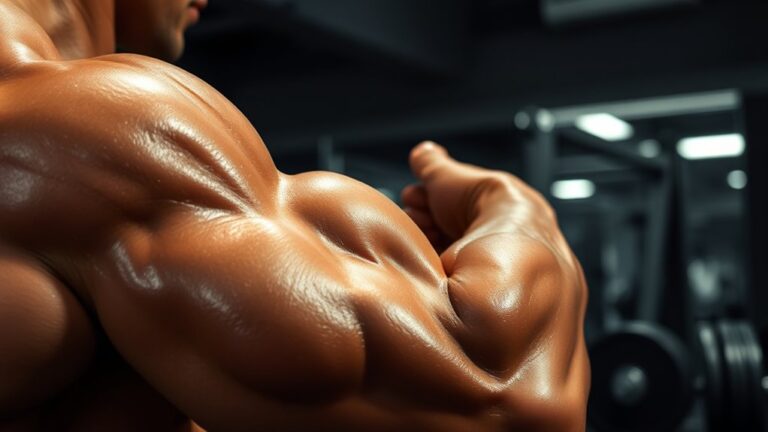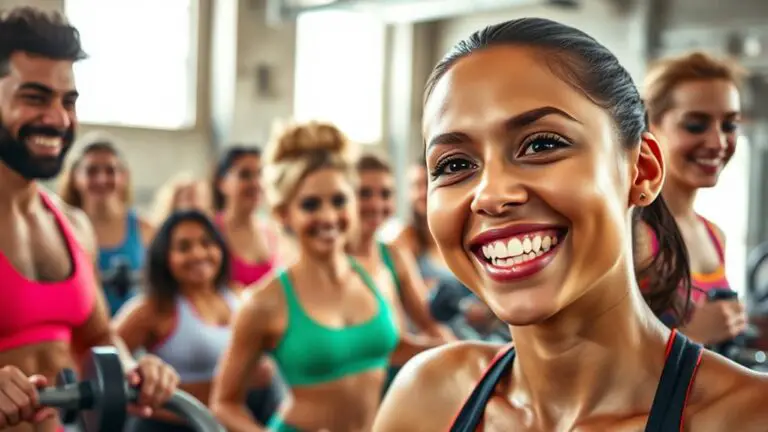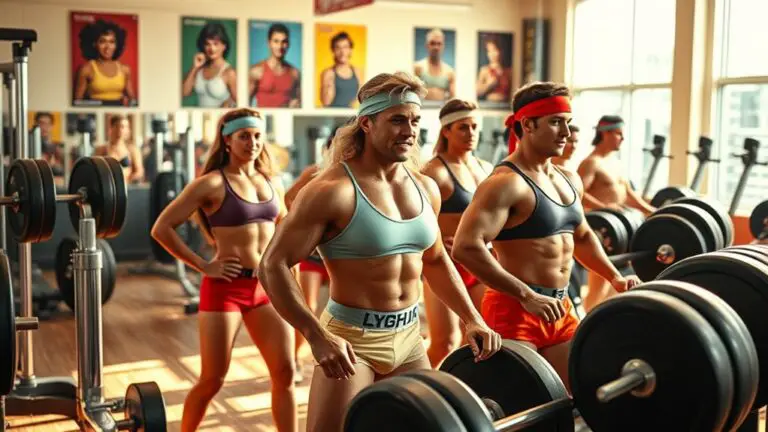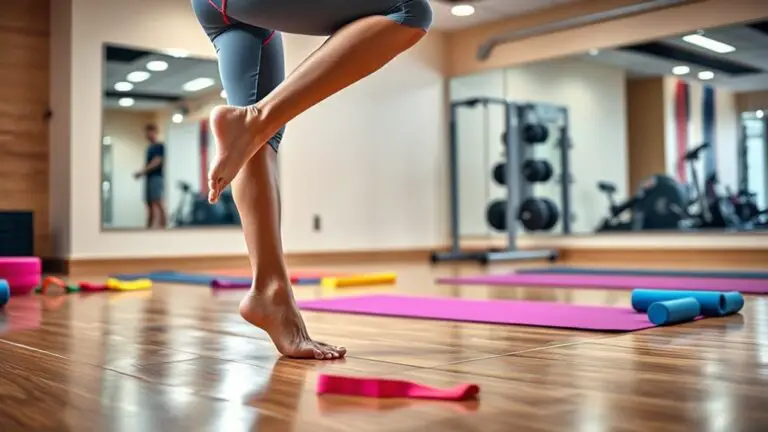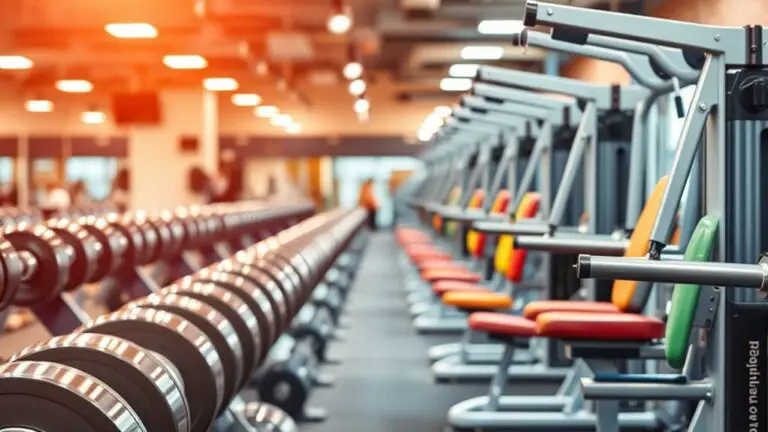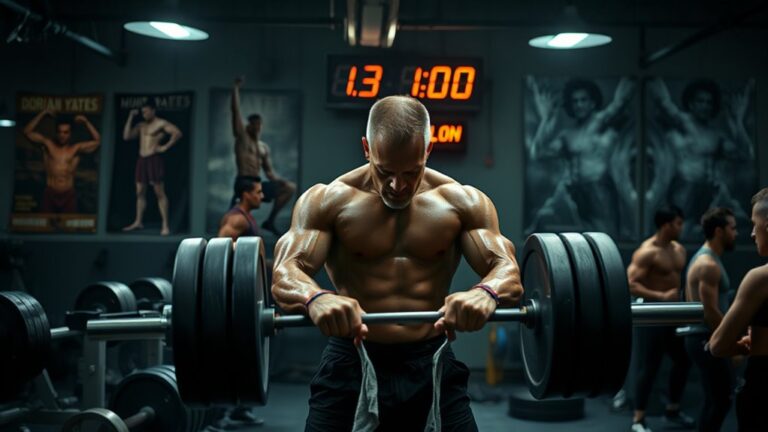The Evolution of Bodybuilding Gym Training Over the Decades
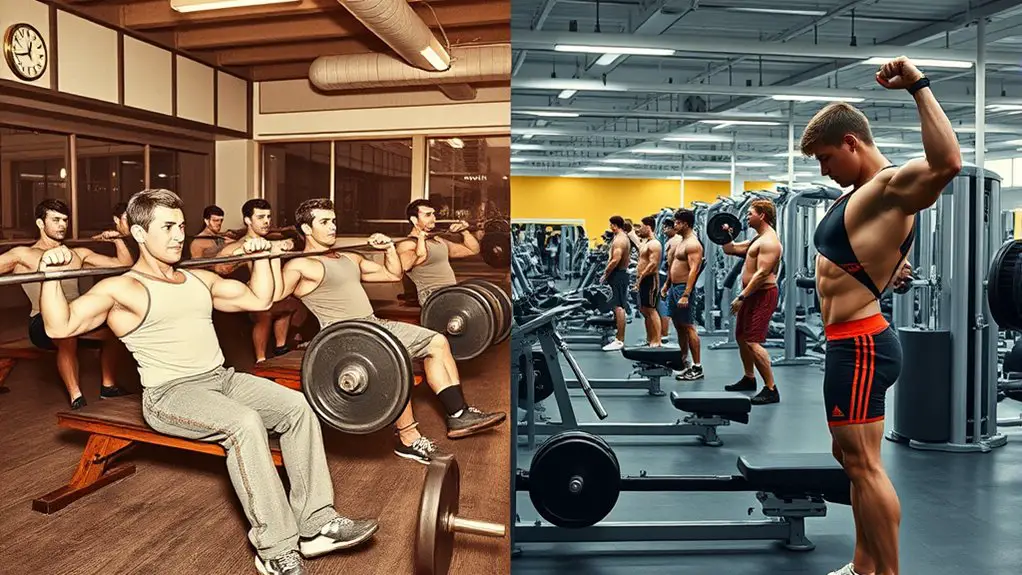
The evolution of bodybuilding gym training reflects significant societal and scientific changes over the decades. You’ve seen it transform from the early 20th century’s focus on aesthetics to the Golden Era, where iconic figures shaped mainstream culture. Innovations in nutrition and specialized gyms now cater to diverse needs, while technology enhances training experiences. Meanwhile, inclusivity trends and a shift towards functional fitness mark a new chapter. Explore how these developments continue to redefine bodybuilding and influence practices today.
The Birth of Bodybuilding: Early 20th Century
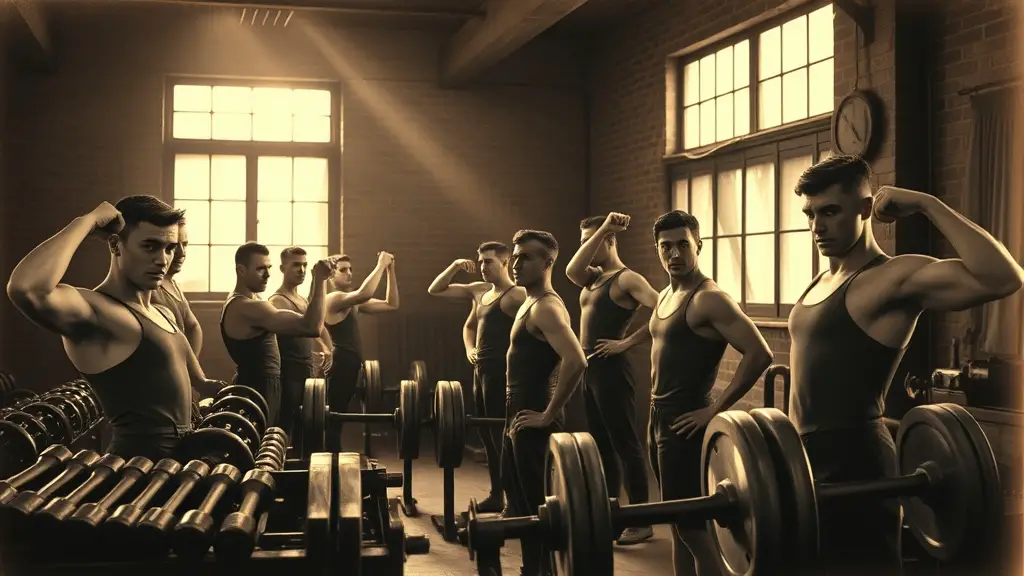
As the 20th century dawned, bodybuilding began to emerge as a distinct discipline, reflecting broader societal shifts towards health and physical fitness. Early influencers like Eugen Sandow and Charles Atlas introduced innovative training philosophies that emphasized aesthetics, strength, and discipline. You’d notice that their methods blended traditional weightlifting with a keen focus on body symmetry and muscular development, setting the stage for future generations.
These pioneers didn’t just promote physical conditioning; they cultivated a culture that celebrated the human form. They understood that bodybuilding was more than mere muscle; it was about crafting an ideal physique through specific training regimens and nutritional practices. Their teachings laid the foundation for modern bodybuilding, merging physical prowess with self-improvement ideals. As you explore this transformative period, it’s clear that these early influencers shaped the landscape of fitness, influencing countless individuals to adopt strength training as a lifelong pursuit.
The Golden Era: The Rise of Iconic Bodybuilders
During the mid-20th century, bodybuilding flourished as a cultural phenomenon, driven by the emergence of iconic figures who transcended the sport and became symbols of strength and discipline. This era, often referred to as the Golden Era, showcased athletes like Arnold Schwarzenegger and Franco Columbu, whose legendary physiques epitomized the golden aesthetics that fans admired.
As you look back, it’s clear that these bodybuilders didn’t just focus on size; they emphasized symmetry and proportion, redefining beauty in strength training. Their charisma and dedication attracted widespread attention, popularizing bodybuilding in mainstream culture.
You might also note how their training regimens combined heavy lifting with a keen understanding of the body’s mechanics, laying the groundwork for future athletes. This period solidified the notion that bodybuilding was not merely a sport but an art form, inspiring countless individuals to pursue their own fitness journeys.
The Influence of Science: Nutrition and Supplementation

As you explore the evolution of bodybuilding, it becomes clear that nutritional advancements have considerably shaped training outcomes. The role of supplements has expanded, with science-backed diet strategies guiding your choices for ideal performance and recovery. Understanding these elements not only enhances your regimen but also reflects a broader shift in the approach to bodybuilding over the decades.
Nutritional Advancements Over Time
While many bodybuilders have historically relied on whole foods to fuel their workouts and recovery, advancements in nutritional science have dramatically transformed how athletes approach their diets. You’ve likely heard about nutrient timing and its impact on muscle recovery, alongside the importance of diet diversity for ideal health. Meal planning now incorporates various protein sources, including options for vegan bodybuilding, while carb cycling and fat adaptation strategies are tailored for distinct metabolic needs. A focus on micronutrients and gut health enhances overall performance, and effective hydration strategies are essential. With meal prep and food tracking, you can better navigate dietary restrictions and metabolic adaptation. Ultimately, nutrition education empowers you to dispel supplementation myths and refine your bodybuilding regimen.
Role of Supplements
The evolution of nutritional science has paved the way for a deeper understanding of supplementation in bodybuilding. You’re now faced with a plethora of options, from protein powders to pre-workout formulas, each promising performance enhancement. However, supplement safety is paramount; knowing the regulatory challenges and ingredient transparency can protect you from harmful substances. With rising industry trends focusing on natural alternatives, personalized nutrition is becoming more accessible, allowing you to tailor your supplementation to your specific needs. Yet, it’s vital to navigate marketing ethics, as not all products are backed by credible science. Staying informed empowers you to make choices that not only enhance your training but also align with safe, effective practices.
Science-Backed Diet Strategies
Nutrition plays an essential role in bodybuilding success, particularly when backed by scientific research. Achieving ideal macronutrient balance is critical, focusing on protein sources and nutrient density. Meal timing can enhance performance nutrition, while hydration strategies support recovery. Exploring calorie cycling and food tracking helps you manage your intake effectively. Plant-based diets are gaining traction, offering diverse nutrients that can fuel your workouts.
| Strategy | Description |
|---|---|
| Macronutrient Balance | Guarantees ideal intake of proteins, carbs, fats |
| Meal Timing | Strategically scheduled meals for energy |
| Nutrient Density | Prioritizing foods high in nutrients per calorie |
| Hydration Strategies | Maintaining water balance for peak performance |
| Dietary Supplements | Supporting nutritional gaps and recovery |
Incorporating these strategies can greatly enhance your bodybuilding journey.
The Advent of Specialized Gyms
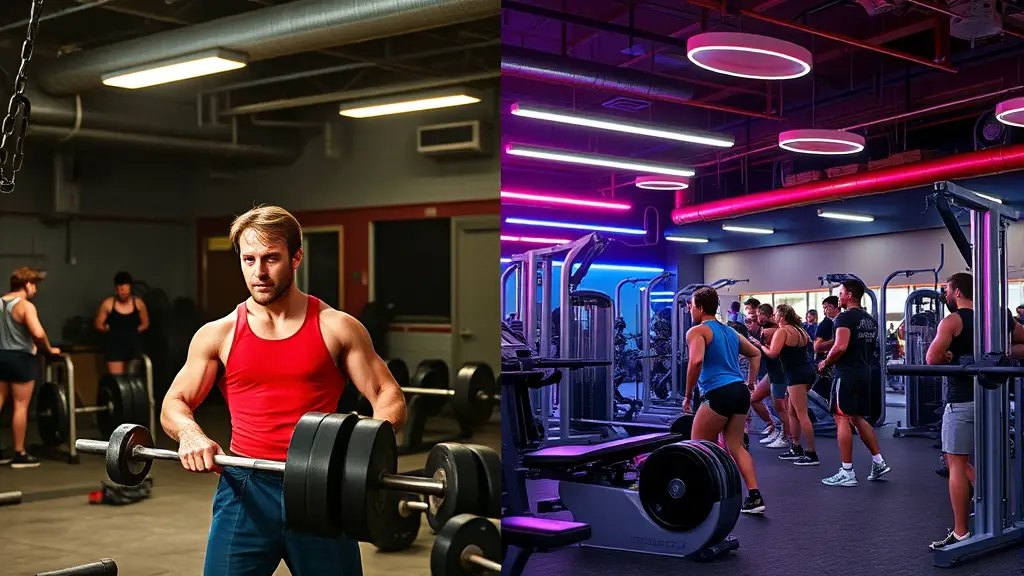
As bodybuilding has evolved, you’ve likely noticed the rise of specialized gyms catering to specific training needs. These niche facilities not only offer targeted training programs but also feature innovative equipment designed for diverse muscle groups. This shift reflects a growing understanding of how tailored environments can enhance performance and results in the fitness community.
Rise of Niche Facilities
In recent years, specialized gyms have emerged as a significant trend in the fitness landscape, catering to specific training styles and communities. These niche facilities focus on niche training, offering specialized equipment that enhances the workout experience. With personalized coaching, members receive tailored guidance, fostering deeper community engagement. The unique atmospheres of these gyms attract individuals who share similar fitness goals, creating a sense of belonging. Fitness trends increasingly highlight holistic wellness, and these specialized centers often incorporate various wellness aspects into their programs. Membership dynamics shift as targeted marketing effectively reaches specific demographics. Additionally, many niche gyms host local competitions, promoting camaraderie and motivation among members while enhancing their visibility in the community.
Focus on Targeted Training
While traditional gyms often offer a one-size-fits-all approach, the advent of specialized gyms has shifted the focus toward targeted training, addressing the unique needs of diverse fitness enthusiasts. These facilities emphasize training specificity, allowing you to hone in on targeted muscles with individualized programs. You can experience greater workout variation through tailored routines that incorporate both compound exercises and isolation movements, maximizing your results. Furthermore, specialized gyms often prioritize recovery techniques, ensuring your body can adapt effectively. Strength periodization is commonly integrated into training plans, enhancing your overall progress. With increased training frequency and goal-oriented sessions, you’ll find that personalized attention in these environments fosters ideal growth and performance, reshaping how you approach bodybuilding.
Equipment Innovation and Diversity
The evolution of specialized gyms has brought about significant advancements in equipment innovation and diversity, reshaping how you engage with your training. Today’s gyms offer a remarkable range of tools that cater to various fitness levels and preferences, thanks to:
- Machine evolution that enhances safety and effectiveness
- Resistance variety for targeted muscle engagement
- Ergonomic designs that reduce injury risk
- Compact equipment and portable tools for versatile use
Moreover, the introduction of adaptive gear and smart technology allows for user customization, enabling you to track progress and optimize workouts. Multifunction devices provide strength diversity, ensuring you can switch between exercises seamlessly. This equipment innovation reflects a deeper understanding of individual needs, promoting a more personalized approach to fitness.
The Role of Technology in Training Equipment
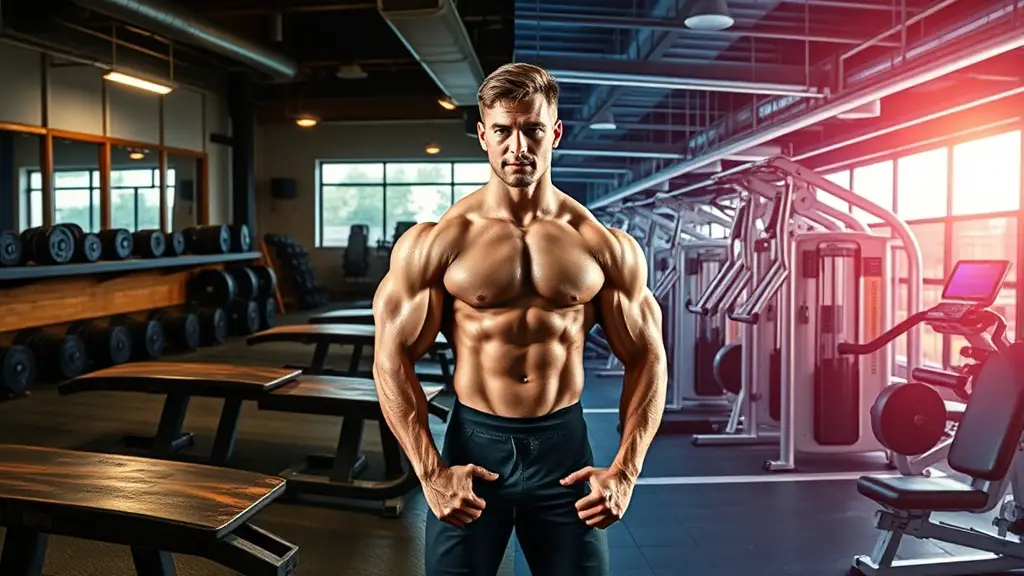
As technology continues to evolve, its impact on training equipment has transformed bodybuilding from a purely physical endeavor into a sophisticated science. Today, smart equipment integrates seamlessly with wearable technology, allowing you to monitor your performance in real-time. Virtual training and augmented reality enhance your workouts, providing immersive experiences that keep you engaged. Fitness apps have revolutionized how you track progress and access personalized routines, while online coaching connects you with experts no matter where you are. Biometric tracking systems gather crucial data, offering insights into your health metrics and performance analytics. Automated workouts adjust to your current fitness level, ensuring ideal results. Digital platforms facilitate community support and motivation, making it easier to share successes and challenges. This technological evolution not only enhances training efficiency but also fosters a deeper understanding of your body’s capabilities, making bodybuilding more accessible and effective than ever before.
The Diversification of Training Techniques
With the evolution of bodybuilding, you’ll find that the diversification of training techniques has become a hallmark of modern fitness regimens. Today, you’re not just limited to traditional weightlifting; instead, you can explore a variety of methods tailored to your goals. This shift incorporates innovative periodization strategies and hybrid training, blending resistance exercises with cardio for optimized results.
The evolution of bodybuilding now offers diverse training methods, blending traditional weightlifting with innovative techniques for personalized fitness journeys.
Here are some key approaches shaping contemporary training:
- Functional Training: Focuses on movements that mimic everyday activities.
- Supersets and Circuits: Enhances efficiency and intensity by reducing rest periods.
- High-Intensity Interval Training (HIIT): Combines short bursts of intense exercise with recovery.
- Periodization Models: Cycles through different training phases to maximize strength and muscle growth.
Incorporating jump rope into your routine can also enhance cardiovascular fitness and provide a full-body workout.
The Impact of Social Media and Online Communities
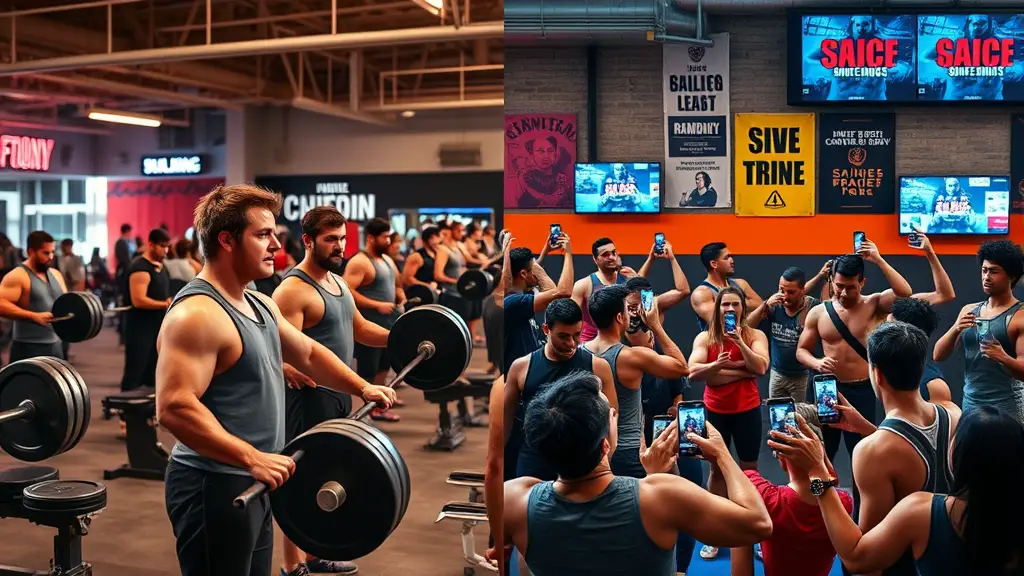
Social media has transformed how you engage with bodybuilding, amplifying the influence of fitness personalities who shape trends and techniques. As you navigate these platforms, online training communities offer not just support but also a space for shared knowledge and motivation. This interconnectedness has redefined your approach to training, making it both a personal journey and a collective experience.
Influencer Culture’s Rise
The rise of influencer culture has dramatically transformed bodybuilding and fitness training, largely driven by the pervasive influence of social media and online communities. You witness a shift where fitness authenticity is paramount, as followers seek relatable coaches and trainers. Key elements of this transformation include:
- The surge in influencer marketing, creating new sponsorship opportunities.
- The emphasis on audience engagement through interactive content creation.
- The growth of online coaching, allowing trainers to connect globally.
- Brand collaborations that shape the industry landscape.
This social media impact fosters a community where everyone’s progress is shared, and personal stories resonate. As a result, aspiring bodybuilders navigate a more connected, yet sometimes superficial, fitness environment, balancing authenticity with the pressures of public perception.
Online Training Communities
In an era defined by digital connectivity, online training communities have emerged as powerful platforms for bodybuilders to share knowledge, experiences, and support. These interactive platforms foster community support through virtual coaching and training forums, allowing you to connect with like-minded individuals. Fitness apps enhance this experience by providing digital resources that track progress and facilitate remote workouts. Online challenges and competitions further motivate you, creating a sense of accountability and social engagement. The combination of these elements transforms traditional training, enabling you to participate in a global fitness culture. As you navigate these communities, the wealth of information and camaraderie available can greatly enhance your bodybuilding journey, making it more accessible and enjoyable than ever before.
The Shift Towards Functional Fitness
As fitness enthusiasts increasingly prioritize overall health and performance, a noticeable shift towards functional fitness has emerged within bodybuilding circles. This evolution reflects a deeper understanding of how training can enhance everyday movement and athletic prowess. You’ll find that functional training emphasizes:
A growing focus on functional fitness in bodybuilding enhances everyday movement and athletic performance.
- Strength mobility to improve flexibility and joint health.
- Core stability for better posture and injury prevention.
- Dynamic exercises that mimic real-life movement patterns.
- Body awareness to cultivate a more holistic wellness approach.
Additionally, incorporating reverse curls can further enhance bicep strength while promoting overall muscle balance.
Gender Inclusivity in Bodybuilding
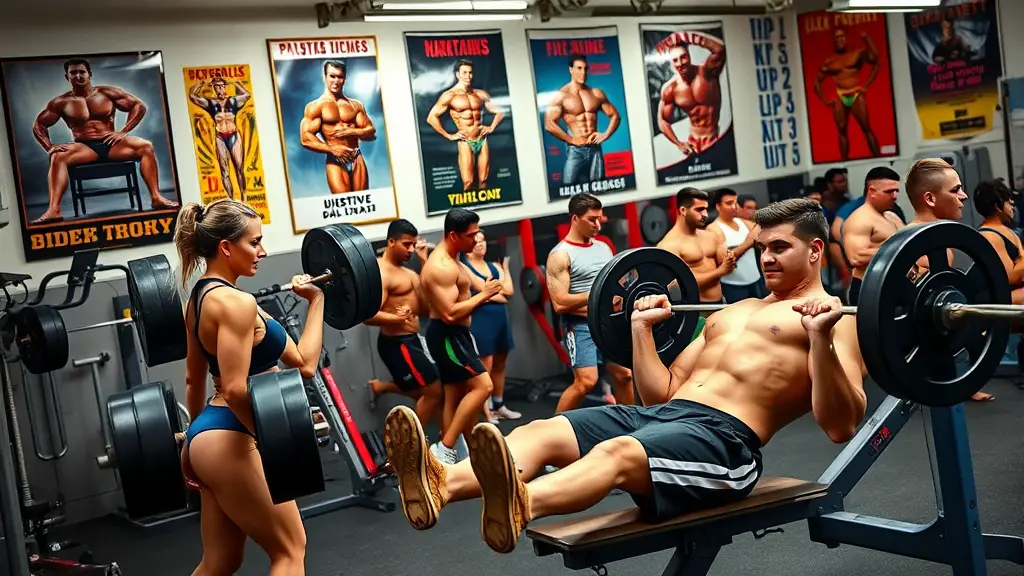
While bodybuilding has traditionally been seen as a male-dominated sport, there’s been a significant shift towards gender inclusivity that’s reshaping the landscape. This evolution emphasizes gender representation and the importance of creating inclusive spaces where everyone feels welcome. Female empowerment is at the forefront, encouraged by diverse role models who challenge outdated norms.
Organizations are increasingly focused on providing equal opportunities, promoting body positivity, and fostering supportive communities that uplift all athletes. Breaking stereotypes has become vital, as representation matters in motivating individuals of all genders to pursue bodybuilding.
However, accessibility issues still persist, limiting participation for some. Addressing these challenges is essential for the ongoing transformation of bodybuilding into a more equitable arena. By embracing inclusivity, the sport not only broadens its appeal but also enhances its overall strength, showcasing the vast potential within a diverse range of athletes.
The Future of Bodybuilding: Trends and Innovations
The evolving landscape of bodybuilding not only reflects a commitment to inclusivity but also sets the stage for exciting trends and innovations that are shaping its future. You’ll likely see advancements integrating technology and wellness, enhancing your training experience. Key trends include:
- Wearable technology that tracks performance metrics, providing real-time feedback.
- Virtual reality environments that immerse you in workouts, making routines more engaging.
- Personalized coaching utilizing data analytics and genetic profiling to tailor programs to individual needs.
- Eco-friendly gyms that focus on sustainability while promoting community engagement.
As bodybuilding embraces hybrid training models, blending traditional methods with innovative approaches, mental wellness and recovery innovations are becoming integral. For instance, the integration of proper technique can help mitigate the risk of injury while enhancing overall performance. With mobile apps facilitating adaptive training and community support, the future of bodybuilding is poised to be more inclusive, tech-savvy, and holistic than ever before.
Frequently Asked Questions
How Has Bodybuilding Influenced Mainstream Fitness Culture?
Bodybuilding’s influence on mainstream fitness culture is profound. You’ve likely noticed how bodybuilding aesthetics have shaped popular fitness trends, from workout routines to diet plans. It’s not just about lifting weights; it’s about sculpting the body to achieve a certain ideal. As gyms embrace these aesthetics, you’re seeing more emphasis on physique competitions and transformation challenges, motivating many to adopt rigorous training regimens and nutritional strategies once reserved for bodybuilders.
What Are Common Misconceptions About Bodybuilding Training?
When it comes to bodybuilding training, common misconceptions often revolve around mythical gains and protein overload. You might think that lifting heavier weights constantly will lead to exponential muscle growth, but that’s not always the case. Quality, not just quantity, matters in training. Additionally, overemphasizing protein intake can lead to health issues rather than muscle gains. Understanding these pitfalls can help you navigate the complexities of effective bodybuilding training more wisely.
Are There Age Restrictions in Bodybuilding Competitions?
Imagine a young athlete stepping onto a stage, muscles gleaming under bright lights, ready to showcase their hard work. In bodybuilding competitions, age eligibility varies by organization. Many allow youth bodybuilding categories for competitors as young as 12, while others might set minimum ages at 16 or 18. These restrictions guarantee safety and maturity, helping to create a level playing field for athletes at different life stages. Whether you’re young or seasoned, there’s a place for you.
How Do Different Cultures Approach Bodybuilding?
Different cultures approach bodybuilding through unique lenses, shaped by their values and traditions. In some places, cultural bodybuilding emphasizes aesthetics and muscularity, while others focus on functional strength and athleticism. Global influences have introduced diverse training methods and nutrition practices, blending styles and philosophies. You’ll find that in certain cultures, bodybuilding isn’t just a sport but a way of life, reflecting social status, discipline, and community. Understanding these nuances can enhance your own training approach.
What Is the Environmental Impact of Gym Equipment Production?
When you consider the environmental impact of gym equipment production, it’s essential to evaluate the use of sustainable materials and energy consumption. Many manufacturers are shifting towards eco-friendly materials, which can greatly reduce waste and carbon footprints. However, the energy consumption during production remains a challenge. By prioritizing efficiency in manufacturing processes and sourcing materials sustainably, you can help minimize the ecological impact while still enjoying your workouts.
